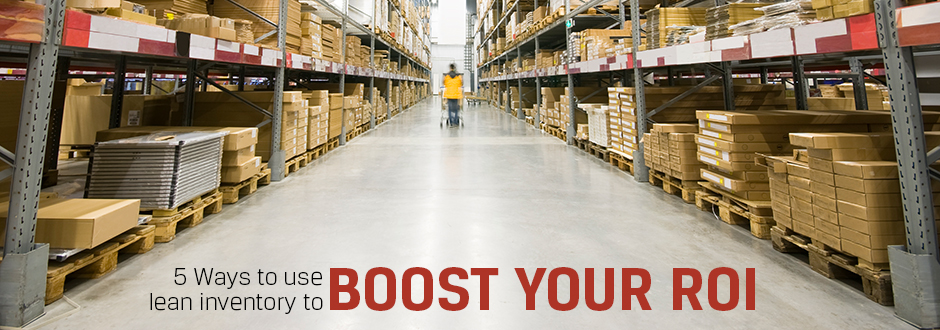Wasp Barcode Technologies: The Barcode Solution People
5 Ways to Use Lean Inventory to Boost Your ROI

If you’re a small business, lean inventory management may be a profit-boosting opportunity. Inventory management has a direct effect on your business’ level of effectiveness. You need to know the
state of your physical inventory, as well as the level of demand for that inventory.
When a business carries too much inventory, it tends to spend more on overhead. In some cases inventory may be losing value. On the other hand, when inventory is too lean, a company runs the risk of not being able to deliver its products in a reasonable amount of time in order to meet demand.
According to Forbes,
GDP is notably affected by inventory.
[su_divider top="no" size="2"]
“Inventory swings destabilize the economy, and now many businesses are carry too much inventory, to the detriment of themselves as well as the entire country.” Bill Conerly
[su_divider top="no" size="2"]
What is the origin of lean inventory?
In the 1940’s Toyota began to manufacture automobiles. While striving to develop an efficient manufacturing system that was good at eliminating waste, they derived the methodology of Lean
Inventory Management. The goal was to create the most effective process. Today, lean inventory has become popular in many industries and in businesses of all sizes. When you right size your inventory, the five major categories of finished goods, sub assembly, office supplies, raw components and MRO will have a size that is just right.
Here are 5 ways lean inventory can benefit your business:
1. Pre-asses you company’s suitability for lean inventory
Changing your business processes is costly. That’s why you need to find out if it makes sense for your company. Fortunately, you can analyze your business processes to see if the benefits will be cost effective. According to Adam Sommers of
Tefen NY "When companies transition to lean, they are more susceptible to changes among their suppliers, and more sensitive to fluctuations in their supply lines".
Important questions that you should answer are:
- What must you do to convert to lean inventory management?
- How much will the conversion cost?
- How much will you save by implementing lean inventory?
- How does your forecast look? Does the cost analysis show that your proposed process change will be cost effective?
Answering these questions requires a great deal of honesty and critical assessment. You need to uncover those things that are well done as well as those things that your company struggles with. Implementing a new process will only succeed when it’s on the solid foundation of a well-designed operational structure.
Creating value for your customers should always be the ultimate goal. This is an essential principle of lean inventory management.
2. Implement demand based flow to be cost effective

The flow of inventory through your warehouse affects the value that you offer your customers, as well as the overall value of your business. In a lean manufacturing setting, inventory is only processed by a production center when it’s needed to fill a customer’s order. It’s easy to overproduce if your production is based on anticipated demand. A major waste of time is due to product searches. Make it
easy to locate inventory and spend the saved time on more valuable activities. Excessive inventory leads to higher storage costs.
3. Pull don’t push your inventory
Conventional push based operations use historic data as a basis for inventory management. The result is often wasteful and costly overstocking of obsolete items.
In a pull based model, only minimal inventory is stocked, replenished as needed. Effective pull based demand management requires continuously monitoring inventory flow.
4. Responsiveness leads to cost effective inventory
Demand for inventory is constantly changing. A continuous and rigorous evaluation of your inventory flow, along with effective demand management, empowers you to respond and quickly adapt to market changes—when applied with business intelligence you will keep your inventory at the ready.
Care must also be taken that lean inventory isn’t overly lean. According to Gartner,
Honda’s sales declined by 28% in a single month due to inventory shortfalls. In another example, shortages in lifesaving
cancer medication also left some patients at risk. Such examples illustrate how important it is to correctly determine inventory reserve.
[su_divider top="no" size="2"]
[su_divider top="no" size="2"]
5. Commit to a continuous process of perfection
Commit to continuous refinement of your entire inventory management process. It will improve efficiency, cost, quality and cycle time, while supporting responsiveness to changing conditions. The essence of the lean inventory concept is based on continuous product and process improvement in tandem with waste elimination.
Summary
Utilizing these
inventory management principles will save you money and strengthen your overall business strategy. Innovative inventory management techniques can improve service, reduce overhead and help foster more opportunities for growth.
To learn more about inventory management software to boost your ROI, contact System ID at 888.648.4452.
 If you’re a small business, lean inventory management may be a profit-boosting opportunity. Inventory management has a direct effect on your business’ level of effectiveness. You need to know the
If you’re a small business, lean inventory management may be a profit-boosting opportunity. Inventory management has a direct effect on your business’ level of effectiveness. You need to know the  The flow of inventory through your warehouse affects the value that you offer your customers, as well as the overall value of your business. In a lean manufacturing setting, inventory is only processed by a production center when it’s needed to fill a customer’s order. It’s easy to overproduce if your production is based on anticipated demand. A major waste of time is due to product searches. Make it
The flow of inventory through your warehouse affects the value that you offer your customers, as well as the overall value of your business. In a lean manufacturing setting, inventory is only processed by a production center when it’s needed to fill a customer’s order. It’s easy to overproduce if your production is based on anticipated demand. A major waste of time is due to product searches. Make it 

